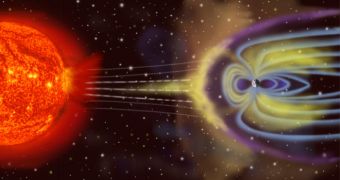Another idea coming from the SF culture is moving in the direction of becoming a reality: spaceship shields. However, as such, they would not protect the ships against evil alien races, but against a more common natural phenomenon. It is a known fact that space weather – the radiation coming from Sun and from the outer space – is the largest obstacle in the way of sending manned missions into space. This is because the intense radiation poses a considerable threat to the safety of the astronauts. Moreover, the solar storms are frequent enough to make long treks highly risky.
While a trip to the Moon and back is possible, since the whole mission only takes about 8 days, a manned voyage to Mars lasting a year and a half may not be so easy to accomplish. Scientists have long since agreed that a surrounding shield for the spacecraft, protecting it from the radiation, much like Earth's magnetosphere does, would be a good solution. However, the technology and tools needed to build such a shield were thought to be out of reach.
The technology would rely on nuclear fusion, the process which is currently used to obtain energy, in order to scatter the ionized particles away from the ship. But, as experts previously believed, only an extremely large (over 100 km across) magnetic field would be appropriate for the job. Still, recent research performed by a number of scientific institutions worldwide demonstrated that this was not the case, and that a “magnetic bubble” only a few hundred meters wide would do the trick.
Computer simulations performed in Lisbon have been confirmed by lab tests in the UK, based on 50 years of experience in nuclear fusion, coming to validate the fact that a small hole in the space weather caused by the solar wind would be enough to ensure the safety of both the human crew, and of the ship and its electronic devices. As Dr. Ruth Bamford, a researcher from the Rutherford Appleton Laboratory, explains, “These initial experiments have shown promise and that it may be possible to shield astronauts from deadly space weather.”

 14 DAY TRIAL //
14 DAY TRIAL //